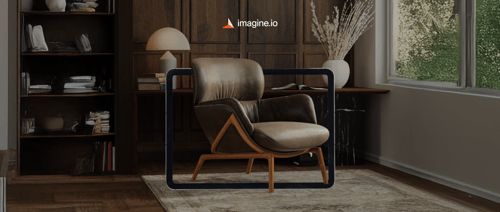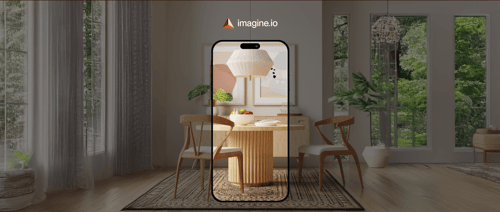Imagine a bustling furniture retailer gearing up for a major product launch. Their catalog includes hundreds of items, each requiring a dizzying array of images different angles, finishes, and settings to captivate online shoppers across platforms like Instagram and retail partner sites. A traditional photoshoot could take weeks, drain budgets, and still fall short of the variety needed to compete in today's e-commerce arena. Now, picture generating those same images in mere minutes, with quality so lifelike that even seasoned e-commerce directors can't spot the difference. This is the power of AI-driven 3D visualization, and it's revolutionizing how retailers in cities like Austin, Chicago, and beyond create visual content at scale.
AI-Powered Visuals: Fueling Retail's Demand for Speed and Scale
The e-commerce landscape is unforgiving. Retailers managing vast or intricate catalogs think furniture brands like Ruggable or appliance makers like KitchenAid face relentless pressure to produce fresh, high-quality visuals. A single product might need dozens of images: a sofa in multiple fabrics, a refrigerator in various finishes, or a lamp staged in different room aesthetics. Traditional photography, with its steep costs and lengthy timelines, is buckling under this demand.
AI-powered platforms like imagine.io are stepping in to fill the gap. By leveraging cloud-based technology, these platforms allow brands to upload a 3D model and generate photoshoot-quality visuals in minutes. Studies conducted by imagine.io reveal that even e-commerce experts struggle to distinguish their AI-generated assets from traditional photos. This isn't about cutting corners it's about empowering brands to scale their visual output while maintaining consistency and quality across platforms like LinkedIn, YouTube, and beyond.
According to a Grand View Research report, industry leaders praise the precision of AI-driven solutions. Brian Moore, VP at NICCA USA, Inc., notes, “The quality of research they have done for us has been excellent,” highlighting the trust that companies place in advanced AI tools to deliver reliable results.
The Evolution from Photoshoots to AI-Driven Variants
The retail industry is undergoing a seismic shift. Gone are the days when brands relied solely on labor-intensive photoshoots to showcase their products. AI is ushering in a new era of efficiency, enabling retailers to produce versatile, high-quality visuals with unprecedented ease.
Omnichannel Consistency for Seamless Branding
In omnichannel retail, consistency is non-negotiable. Whether a customer is browsing Kichler's lighting collections on Facebook or exploring Maytag's appliances on a partner's website, the imagery must feel cohesive. AI platforms ensure that visuals maintain a unified look across web, social media, and retail channels, reinforcing brand identity and driving customer trust.
Localized Visuals for Global Markets
Retailers targeting regions from Los Angeles to Canada need visuals that resonate locally. AI makes this possible by adapting imagery to suit regional preferences a dining table styled for a cozy Chicago brownstone or a sleek Las Vegas condo. With a single 3D model, brands can generate tailored visuals for diverse markets, streamlining global campaigns without inflating costs.
Interactive 3D Configurators
Interactive configurators are redefining customer engagement. Picture a shopper on Sinomax-USA's website, customizing a mattress with different colors or textures, each option rendered instantly in photorealistic detail. AI-driven 3D configurators not only enhance the shopping experience but also reduce the need for physical prototypes, saving time and resources.
Real-World Impact: Brands Embracing AI Visuals
From furniture to consumer goods, leading brands are harnessing AI to streamline their visual workflows and stay ahead of the competition.
Furniture and Home Goods
Furniture retailers like King Koil are using AI to showcase products in a variety of settings modern apartments, rustic cabins, or minimalist studios without the hassle of repeated photoshoots. This flexibility allows brands to create immersive online experiences, helping customers envision products in their own homes and boosting conversion rates.
Consumer Appliances
Appliance brands like Amana are leveraging AI to produce color and finish variants for promotional campaigns. A new dishwasher in a seasonal color? AI can render it in every possible shade, ready for a holiday rollout in hours rather than weeks, keeping pace with fast-moving market trends.
Food and Beverage Packaging
Consumer packaged goods giants like PepsiCo are turning to AI for rapid prototyping. Whether testing new bottle designs or label variations for global markets, AI delivers photorealistic mockups in minutes, enabling marketing teams to iterate quickly and launch campaigns with confidence.
Navigating Challenges in AI Adoption
Despite its transformative potential, AI adoption in retail comes with challenges that brands must address to fully embrace the technology.
Subscription Models vs. Project-Based Costs
One hurdle is the subscription-based pricing of platforms like imagine.io. Unlike one-off photoshoots, subscriptions require ongoing investment, which can seem daunting. However, the value lies in unlimited asset creation at a predictable cost, making it ideal for brands with high-volume or complex catalogs.
Integrating with Creative Workflows
Creative teams often rely on established agency partnerships, and AI can feel like an unfamiliar addition. Convincing designers to adopt platforms like imagine.io requires showcasing its seamless integration and ability to enhance, rather than replace, their creative expertise.
Authenticity Concerns
Some retailers worry that AI-generated visuals lack the authenticity of traditional photography. Yet, imagine.io's rigorous testing shows that their assets are indistinguishable from real photos, even to e-commerce experts. Overcoming this skepticism requires hands-on demos and tangible results to build confidence.
Seizing Opportunities with AI-Driven Visuals
AI's benefits go beyond efficiency, unlocking creative and operational advantages that are reshaping retail.
Cost-Effective Asset Creation
Platforms like imagine.io enable brands to generate unlimited visuals without skyrocketing budgets. Retailers like Hunter Fan can scale their online presence across markets like Dallas or New York, producing thousands of variants from a single 3D model.
Accelerated Time-to-Market
In retail, speed is critical. AI slashes campaign preparation from weeks to hours, allowing brands like Diageo to roll out new packaging visuals for global launches with remarkable agility.
Hyper-Personalized Visuals
AI empowers brands to tailor visuals to specific customer segments or regional trends. A retailer in High Point might showcase furniture in rustic settings, while one in Los Angeles opts for modern aesthetics all rendered instantly from the same model, delivering personalization at scale.
The Future of Retail Visuals
AI-driven visualization is no longer a futuristic concept it's a necessity for retailers navigating the demands of modern e-commerce. By combining speed, scale, and uncompromising quality, platforms like imagine.io are redefining how brands bring their products to life. As adoption grows, experts predict a shift in creative budgets from production to strategy, freeing retailers to focus on innovation and customer engagement. For brands in furniture, appliances, or consumer goods, the choice is clear: embrace AI-powered visuals now or risk falling behind in a market that moves at lightning speed.
Frequently Asked Questions
How can AI help retailers create product photo variants without traditional photoshoots?
AI-powered platforms like imagine.io allow retailers to upload a single 3D model and generate photoshoot-quality visuals in minutes, creating unlimited product variants across different angles, finishes, and settings. This technology enables brands to produce thousands of high-quality images from one model, eliminating the need for costly and time-consuming traditional photography while maintaining visual consistency across all marketing channels.
What types of retailers benefit most from AI-generated product visuals?
Furniture retailers, appliance manufacturers, and consumer packaged goods companies see the greatest benefits from AI visual automation. Brands like Ruggable, KitchenAid, and King Koil use AI to showcase products in multiple settings, colors, and finishes without repeated photoshoots. This is especially valuable for retailers with complex catalogs requiring dozens of images per product or those targeting multiple regional markets with localized visual content.
Are AI-generated product images as realistic as traditional photography?
Yes, studies show that even e-commerce experts struggle to distinguish high-quality AI-generated visuals from traditional photographs. Platforms like imagine.io have conducted rigorous testing proving their AI assets are indistinguishable from real photos, addressing authenticity concerns while delivering the speed and scale advantages that modern retail demands. This photorealistic quality maintains brand credibility while dramatically reducing production costs and timelines.
Disclaimer: The above helpful resources content contains personal opinions and experiences. The information provided is for general knowledge and does not constitute professional advice.
You may also be interested in: Why the Future of Product Photography is Virtual: The Rise of 3D Rendering
Struggling with expensive, outdated product visuals that slow down your creative process and stunt eCommerce growth? imagine.io's AI-powered platform empowers furniture, home décor, and textile brands to effortlessly produce striking 3D images, immersive videos, AR experiences, and interactive configurators. Cut production costs up to 70%, boost conversions 5X, speed up prototyping, and supercharge your online sales. Ready to elevate your product visuals and captivate customers? Book a demo with imagine.io today!
Powered by flareAI.co




.png?width=500&name=How%20to%20Add%20a%203D%20Product%20Configurator%20to%20Your%20WordPress%20Website%20(Complete%20B2B%20Guide).png)
















%20(1).png?width=500&name=Why%20Exploded%20Mattress%20Views%20Matter%20(And%20How%20to%20Generate%20Them)%20(1).png)
.png?width=500&name=Best%20Shopify%20Product%20Configurator_%20How%20to%20Choose%20the%20Right%20One%20(2).png)
.png?width=500&name=Why%20Exploded%20Mattress%20Views%20Matter%20(And%20How%20to%20Generate%20Them).png)



.png?width=500&name=Best%20Shopify%20Product%20Configurator_%20How%20to%20Choose%20the%20Right%20One%20(1).png)







.png?width=500&name=How%203D%20Rendering%20Can%20Make%20or%20Break%20Your%20Industrial%20Design%20Pitch%20(1).png)








%20with%20Digital%20Twins%20and%203D%20Visualization.png?width=500&name=Optimizing%20Your%20Digital%20Asset%20Management%20(DAM)%20with%20Digital%20Twins%20and%203D%20Visualization.png)




.png?width=500&name=Styling%20Home%20Decor%20for%202025_%20From%20Global%20Influences%20to%20Playful%20Personalization%20(1).png)
